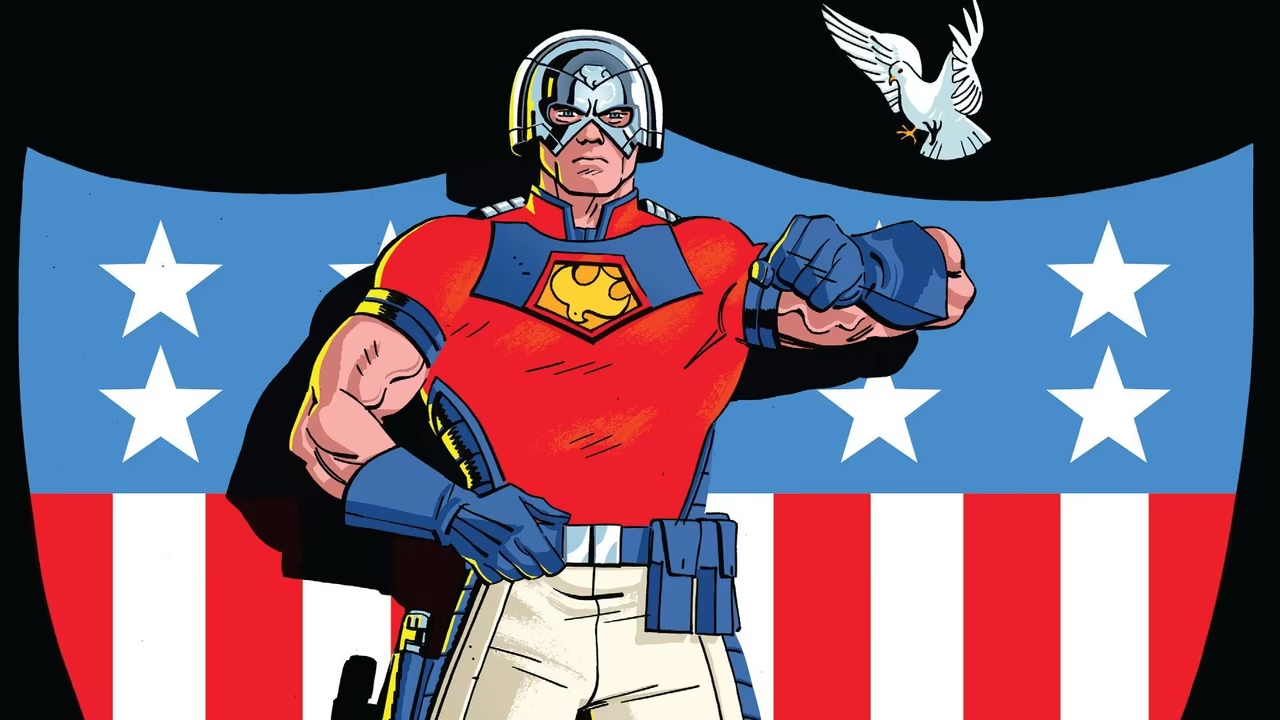By: Andrew Hewitt, PMHNP-BC
Abstract
Christopher “Chris” Smith, known as Peacemaker within the DC Extended Universe, is a vigilante antihero whose inner world is shaped by childhood trauma, rigid moral codes, and escalating violence in service of “peace.” This paper examines his psychopathology using DSM‑5 criteria, focusing on personality structure, trauma-related features, and adaptive/maladaptive defense mechanisms. Recent scholarship and media reviews are integrated to illuminate how Smith’s motivations and behavior reflect antisocial traits, rigid moral convictions, and ongoing identity reformulation.
Introduction
Peacemaker’s character—portrayed by John Cena in The Suicide Squad (2021) and its spin-off series (2022)—offers a rich tapestry for psychiatric analysis. His extreme, literal code of “peace at any cost” stems from early emotional abuse and ideological conditioning under his father, Auggie Smith, a white supremacist vigilante (DC Extended Universe biography) StatPearls+4Reddit+4Reddit+4Wikipedia. From a PMHNP‑BC perspective, we can explore how early trauma, personality traits, and defense mechanisms interact to shape Chris’s moral rigidity and behavioral dysregulation.
Background & Developmental Trauma
As described in canonical backstories, Chris’s father trained him to kill from a young age, and labeled him inferior compared to his deceased brother Keith. Chris’s upbringing involved emotional neglect, possible parental favoritism, and identity distortion—factors that predispose to maladaptive beliefs and pervasive personality patterns WikipediaWikipedia.
Studies show that early childhood emotional trauma, especially within familial bonds, increases risk for developing personality disorders, particularly within Cluster B (antisocial, narcissistic) due to impaired empathy and moral frameworks. These interplays often result in rigid internalized moral narratives and fixated coping styles.
DSM‑5-Informed Personality Profile
Antisocial Personality Traits
Chris exhibits hallmark behaviors aligned with antisocial features: justification of violence, disregard for the rights of others (killing for “peace”), impulsivity (reckless missions), and lack of remorse (executing innocents when ordered). Although fictional, these align with DSM‑5 descriptions of Antisocial Personality Disorder: callousness, deceit, aggressive behavior, and failure to conform to lawful norms (APA, 2013) Social Sci LibreTextsNCBI.
These traits fall under the DSM‑5 pathological trait domain of antagonism and disinhibition, reflecting lower agreeableness and conscientiousness (Hopwood et al., 2012) NCBI+8PMC+8PMC+8.
Rigid Moral Code and Identity Formation
Despite antisocial behaviors, Chris’s internal moral structure is unwavering: he believes in peace—but only if maintained through elimination of threats. This absolutist ethic suggests trait elevations in psychoticism or negative affectivity, tied to suspiciousness and ideological rigidity.
Personality Disorder—Generalized Functioning Impairment
Per DSM‑5-TR, a personality disorder requires impairments in self/interpersonal functioning and pathological traits enduring since adolescence (APA, 2022) StatPearls+1NCBI+1. Chris’s identity as Peacemaker is inflexible, pervades personal and social contexts, and leads to impairment (frequent incarceration, emotional isolation), consistent with a general personality disorder framework.
Emotional and Behavioral Dysregulation
Anger, Impulsivity, and Aggression
Chris frequently responds with rage or violence when his moral code is challenged, or when his authority is questioned (e.g. agents laughing with Vigilante; rejection by his father) StatPearls. These behaviors align with disinhibition—impulsivity and poor behavioral control—as per DSM‑5 trait specifiers (Hopwood et al., 2012) PMCopenbooks.library.baylor.edu.
Defense Mechanisms and Coping Styles
Media analysis suggests Chris relies on immature defenses—splitting (viewing situations as entirely “right” or “wrong”), projection, and acting out—but also some adaptive use of sublimation (redirecting aggression into controlled violence) and suppression (burying grief over his brother) frontiersin.org.
Developmental Shifts and Identity Reformation
In Season 1, Chris undergoes a “dark night” of the soul: he begins to question his role as peace‑delivering murderer. Reddit commentary asserts he experiences existential crisis, moral doubt, and reduced certainty in violence as a solution Reddit.
This shift reflects possible gains in psychological sophistication and emerging integrative capacity, whereby Chris considers his motives and recalibrates his identity—a trajectory consistent with emerging recovery in personality pathology.
Clinical Conceptualization
Formulation Summary
- Trauma origin: emotional abuse, toxic moral ideology from father
- Core personality traits: high antagonism, disinhibition; low empathy, moral overcontrol
- Maladaptive beliefs: “Violence ensures peace”; identity as martyr/vigilante
- Defense patterns: splitting, suppression, reaction formation
Potential DSM‑5 Diagnoses
- Antisocial Personality Disorder (features present, though not formally diagnosable without history of juvenile behavior problems)
- General Personality Disorder with Antisocial Traits (if criteria cannot be fully met)
- Possibly Post-traumatic Stress Features, tied to family trauma and guilt (though not detailed in media sources)
Therapeutic Perspectives
Imaginary Case Considerations
An individual experiencing Chris’s pattern might benefit from:
- Trauma-informed therapy (e.g., EMDR, CPT) targeting early familial conditioning
- Schema therapy to address core beliefs—such as worthlessness, moral absolutism
- Dialectical behavior skills to build emotion regulation and reduce impulsivity
As a PMHNP‑BC, integrating psychopharmacology is not primary in fictional cases, but in a real-world counterpart, SSRIs could help reduce aggression and anxiety; mood stabilizers could mitigate impulse control challenges.
Media as Teaching Tool
Using Peacemaker in psychoeducation helps normalize discussion of rigid moral codes, inherited belief systems, and the complexity of personality pathology. It allows patients to explore identity, accountability, and growth through a compelling narrative lens.
Discussion and Broader Insights
1. Nature versus Nurture: Chris’s case exemplifies a complex interplay—familial indoctrination estrogen his code, temperament predisposes to aggression, and contextual trauma accelerates maladaptive development.
2. Rigid belief systems: Peacemaker illustrates how ideological inflexibility and moral absolutism contribute to conflict escalation, perfectionism, and emotional dissociation.
3. Capacity for change: Season 1 arc demonstrates potential for personality flexibility and meaning reconstruction—a hopeful model for personality‑structured disorders.
4. Translational takeaways for PMHNP‑BCs:
- Recognize how identity and trauma shape behaviors
- Use fictional characters ethically to foster engagement and insight
- Maintain diagnostic humility while acknowledging fictional blurred lines
Conclusion
Christopher Smith, “Peacemaker,” personifies a complex fusion: unwavering moral idealism, trauma-based rigidity, and violence in the name of peace. Viewed through the DSM‑5 framework, his pattern mirrors antisocial interpersonal style, disinhibition, and identity dysfunction. Yet, his narrative arc also offers glimpses of integration and questioning. As PMHNP‑BCs, leveraging such fictional analyses can clarify real-world dynamics—motivation, trauma, rigidity, and potential reform—while inviting deeper dialogue about moral injury, inherited belief systems, and the capacity to become more than our worst histories.
References
American Psychiatric Association. (2013). Diagnostic and statistical manual of mental disorders (5th ed.).
American Psychiatric Association. (2022). Diagnostic and statistical manual of mental disorders (5th ed., text rev.; DSM‑5‑TR).
Hopwood, C. J., Pincus, A. L., et al. (2012). Pathological personality domains capture variance in personality pathology. PMC. frontiersin.orgWikipediaPMC
StatPearls. (n.d.). Personality Disorder: Treatment & Management. NCBI Bookshelf. StatPearls+1NCBI+1
DSM-5 Personality Disorders overview. LibreTexts. Social Sci LibreTextsNCBI
Defense style and DSM‑5 Domains. Frontiers in Psychology. frontiersin.org
Peacemaker (DC Extended Universe). Wikipedia. Wikipedia+1Wikipedia+1
Reddit commentary: Peacemaker identity doubt. r/PeacemakerShow. thedailystrength.com+4Reddit+4Reddit+4
Reddit speculation: Vigilante and ASPD. r/PeacemakerShow. Reddit
Note: This analysis utilizes a fictional character for illustrative educational purposes and is not intended as clinical diagnosis.

